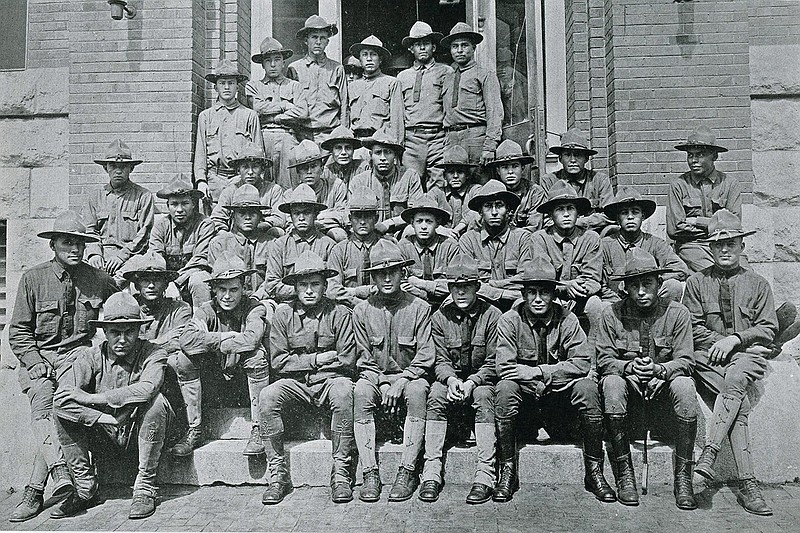UALR researchers aid in effort to ID Native Americans who served in WWI; long-overdue medals sought for vets
Published: 5 December 2022
By Ryan Anderson
via the Arkansas Democrat-Gazette newspaper web site

Former Haskell Institute Students turned WWI soldiers, circa 1918
Former Haskell Institute Students turned WWI soldiers, circa 1918
Sequoyah center working to right a historical wrong
Native American soldiers deserving of honors for their World War I service could soon receive those decorations thanks in part to work being done at the University of Arkansas at Little Rock’s Sequoyah National Research Center.
“Some of these [individuals] never got the recognition they deserved, and their families and relatives may not even know about their actions,” said Erin Fehr, an archivist and assistant director of Sequoyah National Research Center. “Bringing that valor to light is what it’s all about.”
Sequoyah National Research Center is partnering with the George S. Robb Centre for the Study of the Great War at Park University in Missouri, home of the Valor Medals Review Project and Task Force, as a team of researchers and historians are researching African American, Native American, Asian American, Jewish American and Hispanic American soldiers who served from 1914 to 1921, according to Angie Faller, news director at UALR.
To qualify for a review of what, if any, other medals they might be eligible for, the service member must have received a Distinguished Service Cross/Navy Cross and/or the French Croix de Guerre with Palm and/or been recommended for a Medal of Honor but downgraded. So far, more than 200 service members have qualified for review, including two dozen Native Americans.
In addition, Fehr said that in her research, she’s also discovered 14 Native American women served as nurses during the war. Her new “mission,” she said, is to “track down” all those names, and others, if necessary. “I feel there are probably more than 14, and this is a remarkable story nobody knows about.”
The Sequoyah National Research Center, which was originally created in 2005, aims to acquire and preserve the writings and ideas of Native North Americans by collecting the written word and art of Native Americans and creating a research atmosphere that invites indigenous peoples to make the Center an archival home for their creative work, according to the university. The collections there constitute the largest assemblage of Native American expression in the world, and the Center has been working to preserve the history of Native American soldiers who served in World War I for years, making it a felicitous choice for this project.
In 2017, when the Center put together a collection on Native American code talkers of World War I as part of the 100th anniversary of the U.S. entering the war, “we learned that many people don’t even know [Native Americans] fought in World War I,” Fehr said. That led to creating a record to document the “incredible” number who did serve.
From 2017 to 2019, Center employees created a website on American Indians and Alaska Natives in the war for the U.S. World War I Centennial Commission, as researchers sought to identify all of the estimated 12,000 Native Americans who served during World War I, according to Faller. The website, launched in January 2019, contained more than 6,000 names and has since been archived by the Library of Congress.
Read the entire article on the Arkansas Democrat-Gazette web site here:
External Web Site Notice: This page contains information directly presented from an external source. The terms and conditions of this page may not be the same as those of this website. Click here to read the full disclaimer notice for external web sites. Thank you.



